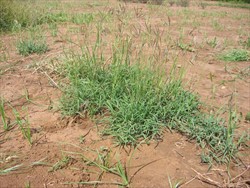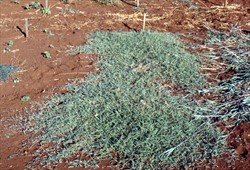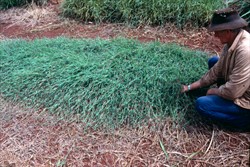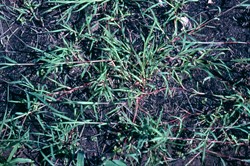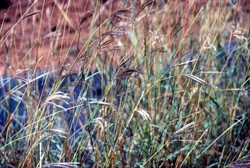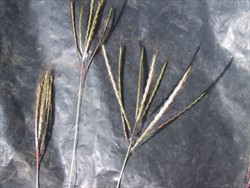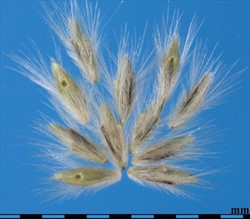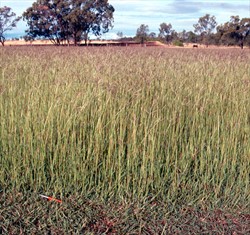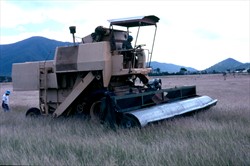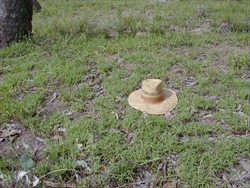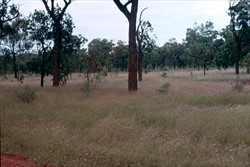Bothriochloa pertusa
Tropical Forages
Bothriochloa pertusa (L.) A. Camus
Basionym: Holcus pertusus L.; Andropogon pertusus (L.) Willd.; Dichanthium pertusum (L.) Clayton
Family: Poaceae (alt. Gramineae) subfamily: Panicoideae tribe: Andropogoneae.
Weakly tufted, stoloniferous perennial; stolons commonly pink to red; culms erect or geniculately ascending, to 50 cm tall pre-flowering and 90 cm at maturity. Leaf blades greyish green, linear, 5‒10 (‒30) cm long, and 2‒6 mm wide; usually glabrous except for few sparse hairs at base; ligule a short, fringed membrane. Flowering culms, 2‒3 branched; nodes glabrous or pubescent. Inflorescence subdigitate, or digitate, purplish in colour, emitting an aromatic odour when crushed; axis 0.5‒3 cm long, with 3‒13 racemes, 2‒7 cm long; spikelets in pairs; sessile spikelet comprising two florets, one fertile bearing geniculate and twisted awn 10‒20 mm long, the other mainly sterile (rarely male); pedicellate spikelet unawned, usually neuter, often bearing a pit in apical third of lower glume. 1.1‒1.6 million seed units/kg (1 seed unit = sessile spikelet + pedicellate spikelet + awn).
Asia: 孔颖草 kong ying cao (China); rebha las-alasan, suket putihan (Indonesia); rumput embun (Malaysia); salay, salay-parang (Philippines); ya-hangma, ya-hom, ya tot lueat (Thailand); huyệt thảo lỗ, hoa cỏ (Vietnam)
English: hurricane pitted-bluestem, hurricane grass, Indian bluegrass, Indian couch grass, pitted beardgrass, sweet pitted grass; Antigua hay, Barbados sour grass, seymour grass (Caribbean); silver grass (New Caledonia)
India: aanekattu hullu, bagi, basana, begi-ghash, chapruro, chhoti-jergi, chikka kaare hullu, chinna karai pullu, chinna karai pully, chinna korai pul, chirrya, chota piya, choti jergi, ghanya marvel, girji, gohhaya, hennu ganjala garike hullu, janewa(h), janu gaddi, janugaddi, jarewa, jinjivo, jinzavo, karadaa kaasi hullu, khet-rav-jinjvo killa, makhel, malhar, malher, miniyar, nukah, paluah, palva, palvan, palwa, palwal, palwan, parwal, payen, phularia, phulra, phulwa, rukah, rukar, sandhor,sandhur, tikria, tikriya, turri gadai, vida-gucha gadi, zinzvo
Latin America: yerba huracán; camagueyana, camagueyna, comagueyana (Cuba); acaba finca (Dominican Republic); carreterograss (Mexico); yerba agria de Barbados, yerba amarga (Puerto Rico)
Native:
Asia: China (Guangdong, Sichuan, Yunnan); India; Indonesia; Laos; Malaysia; Pakistan; Sri Lanka; Thailand; Vietnam
Cultivated/naturalized:
Widely naturalized in tropics and subtropics and cultivated in Australia.
Forage
A permanent pasture for grazing systems in poorer soils. Generally too low for cut-and-carry. Can be ensiled or cut for hay. Little value for standover as it becomes unpalatable with flowering. Can be used in no-till vegetable system in which B. pertusa stands are killed with herbicide prior to introduction of vegetable seedlings, providing mulch.
Environment
Erosion control (soil blanketing), reseeding eroded land, lining floodways, stabilising and revegetating mine waste, and for turf and amenity plantings.
Other
Used in association with Piper spp. as folk medicine by some tribal groups in India.
Soil requirements
Common on neutral to alkaline, cracking clay soils of India, but also grows on well drained, coarse to fine-textured soils with a pH as low as 5.0. Colonises poorer soils where other grasses may not grow, particularly when management favours spread of the species (see Defoliation).
Moisture
Most commonly found in areas with annual rainfall from 600 to 900 mm, but also grows at >2,000 mm rainfall and down to 500 mm. Considered a perennial, drought-evading species, with growth declining rapidly with the onset of dry conditions. Can tolerate short periods of waterlogging.
Temperature
Native and naturalized over a wide latitudinal range, from near the equator to latitude 28º, and from sea level to >2,000 m asl. This equates to a range in average annual temperature from about 17‒27 ºC. There is little growth once grass temperatures reach 3‒4 ºC. Tops and stolons are killed by frost, but stand recovers from the tufted crowns along the stolons, provided grass temperatures do not fall much below about -6 ºC.
Light
Tolerates light shade, but grows best in full sunlight. Does not grow well when shaded by taller pasture plants or weeds.
Reproductive development
Flowering time varies markedly with ecotype, with first flowers emerging from late January to early May in the southern hemisphere subtropics. Late flowering varieties may fail to set seed before the onset of frost in some environments.
Defoliation
Commonly found in heavily grazed or frequently mowed areas of grassland and open woodland. Distribution is strongly controlled by management. It is favoured by heavy grazing or frequent mowing, and represents the first stage in degradation of the Sehima/Dichanthium cover in India. Early flowering varieties in particular should be grazed fairly heavily to reduce the increase in fibre content of the forage that occurs with flowering. Also becomes dominant in heavily grazed, degrading tussock grass pastures, notably those based on Cenchrus ciliaris and Heteropogon contortus.
Fire
Survives fire, recovering from the tufted crowns along the stolons. Severe fire can thin a stand.
Guidelines for establishment and management of sown forages.
Establishment
Established from seed or stolons. High level of dormancy in freshly harvested seed, which breaks down after 4‒9 months storage. Seed best sown on or near the surface of a fine, clean seedbed, at 1‒3 kg/ha. To avoid erosion resulting from cultivation, it can be sown into the ashes following fire, although this results in poorer establishment. Germinates quickly and establishes readily. Difficult to achieve flow of fluffy seed through some mechanical planters unless seed is pelleted.
Fertilizer
Responds to applications of moderately low levels of both nitrogen and phosphorus on very infertile soils, of the order of 10‒20 kg/ha P and 50‒100 kg/ha N.
Compatibility (with other species)
Forms dense sward and can suppress associated species. Companion species must be equally tolerant of heavy grazing.
Companion species
Grasses: Cenchrus ciliaris, Urochloa mosambicensis, Digitaria didactyla.
Legumes: Centrosema pascuorum, Chamaecrista rotundifolia, Listia bainesii, Stylosanthes guianensis var. intermedia, S. hamata, S. scabra.
Pests and diseases
Main diseases in cultivation are leaf rust caused by Puccinia duthiae and ergot caused by Claviceps pusilla. Cultivars vary in their susceptibility to leaf rust. A smut caused by Sporisorium sp., and other fungal diseases caused by Balansia sclerotica, Claviceps purpurea, Physoderma bothriochloae, Puccinia cesatii, P. erythroaeensis, P. pusilla, Sphacelotheca tenuis, Ustilago bothriochloae, and Uromyces andropogonis-annulati have also been reported on B. pertusa.
Not as susceptible to attack by army worm (Spodoptera spp.) and other lepidopterous larvae as the morphologically similar Digitaria didactyla.
Ability to spread
B. pertusa is a very successful coloniser due to its tolerance of low fertility soils and regular defoliation, strong stolon development, the ability to produce significant yields of seed, and the ease of transfer of the fluffy seed by livestock and machinery. Early flowering types are generally the most aggressive in this regard.
Weed potential
Considered a weed of pastures in some areas, although usually a symptom of declining fertility and excessive grazing.
Nutritive value
Quality declines with age and more rapidly with the onset of flowering. CP levels in young leaf may be of the order of 12%, and P, 0.2%, with 70% IVDMD. In a mature stand with large numbers of inflorescences, corresponding values are more of the order of 3 or 4%, 0.05% and 45%, respectively.
Palatability/acceptability
Well eaten when young and leafy. Hayed off material retains its quality and is eaten during the dry season. The yield is low but bluegrass hay is well eaten by cattle and horses.
Toxicity
None reported.
Dry matter
Generally low yielding at 1‒5 t/ha DM, because of the environment in which it mostly grows - poor soils and low rainfall. However, with dry season irrigation, it is capable of producing up to 15 t/ha DM.
Animal production
80‒140 kg LWG /hd/yr with 1.3‒0.7 steers/ha.
2n = mostly 40 (tetraploid), occasionally 60 (hexaploid). Generally considered apomictic, although sexual reproduction demonstrated in some tetraploid ecotypes.
Seed can be harvested manually or mechanically. With direct heading machinery, yields of the order of 70‒100 kg/ha can be obtained. Double this amount of higher quality seed can be produced by making sequential passes with a vacuum assisted brush harvester. As with most grasses, an application of 100 kg/ha N following a clearing cut helps to ensure a high density of well-filled heads.
Killed by glyphosate; tolerant of atrazine.
- Palatable.
- Tolerant of heavy grazing.
- Grows on infertile soils.
- Effective ground cover to combat erosion.
- Invasive with weed potential.
- Not very productiv.e
- Some varieties subject to leaf rust.
- Low late season feeding value of early flowering varieties.
Bisset, W.J. (1980) Indian bluegrass has special uses. Queensland Agricultural Journal 106:507–517.
McIvor, J.G. and Howden, S.M. (1992) Bothriochloa pertusa (L.) A. Camus. In: Mannetje, L.’t and Jones, R.M. (eds) Plant Resources of South-East Asia No. 4. Forages. Pudoc Scientific Publishers, Wageningen, the Netherlands. p. 54–56. edepot.wur.nl/327785
Pengelly, B.C., Staples, I.B. and Scattini, W.J. (1997) Variation in collections of Bothriochloa pertusa and B. insculpta. Genetic Resources Communication No 27. CSIRO Tropical Agriculture, St Lucia, Australia. bit.ly/33HOy2q
Truong, P.N. and McDowell, M (1985) Indian bluegrass for soil conservation and land stabilization in Queensland. Journal of Soil Conservation New South Wales 41:38–44. nla.gov.au/nla.obj-761064000
'Bowen' Unofficially released in Queensland, Australia. Origin unknown. Naturalized around Bowen in N Queensland. Stolons about 1.5 mm diameter, 25‒40 cm high (‒60 cm at maturity) early flowering (commencing late January in southern hemisphere subtropics). Morphologically similar to 'Emerald' but earlier flowering. Susceptible to rust. Least desirable ecotype from forage perspective. 2n = 40.
'Capella' Unofficially released in Queensland, Australia. Origin unknown. Naturalized around Capella in the Central Highlands Region of Queensland. Flowering commences late April in southern hemisphere subtropics.
'Dawson' Released in Queensland, Australia in 1991. Origin unknown. Naturalized around Biloela in subcoastal Central Queensland. Fine, densely stoloniferous (stolons dark red, c. 1 mm diameter), low growing (10‒30 cm, ‒50 cm at maturity), late flowering (commencing early May in southern hemisphere subtropics) type, selected as a turf variety. Widely adapted. Rust (Puccinia duthiae) resistant.
'Emerald' or 'Emerald Downs' Unofficially released in Queensland, Australia. Origin unknown. Naturalized around Emerald in the Central Highlands Region of Queensland. Morphologically similar to 'Bowen', although slightly taller, with slightly finer stolons and later flowering. Susceptible to rust.
'Ghana Marvel 20' Released in Maharashtra State, India. High yielding variety, producing 40‒100% more dry matter than local strain.
'Keppel' Released in Queensland, Australia in 1987. Origin unknown. Naturalized around Yeppoon in coastal Central Queensland. Very robust type, with foliage to 50 cm and mature culms to 80 cm. Flowering commences early May in southern hemisphere subtropics. Rust resistant. Widely adapted. Good forage variety.
'Medway' Released in Queensland, Australia in 1991. Origin unknown. Naturalized on Medway Station near Bogantungan west of Emerald in Queensland. More robust type, with foliage to 50 cm and mature culms to 80 cm. Flowering commences late March in southern hemisphere subtropics. Rust resistant. Appears best adapted to lower rainfall areas. Good forage variety. 2n = 60.
CPI 59586 Selected in Queensland. Origin Moshi, Tanzania (4º S, 667 m asl, rainfall 750 mm). Good agronomic performance in humid subtropics of Queensland.
CPI 104642 Selected in Queensland. Origin Madhya Pradesh, India (23.15º N, 460 m asl, rainfall 1,200 mm). Good agronomic performance in sub-humid central Queensland.
CPI 104935B Selected in Queensland. Origin Madhya Pradesh, India (22.37º N, 310 m asl, rainfall 1,200 mm). Good agronomic performance in central Queensland.
CPI 104968 Selected in Queensland. Origin Madhya Pradesh, India (22.39º N, 520 m asl, rainfall 1,030 mm). Good agronomic performance in sub-humid central Queensland.
CPI 106629 Selected in Queensland. Origin Tamil Nadu, India (11.12º N, 350 m asl, rainfall 700 mm. Good drought tolerance.
CPI 106712 Selected in Queensland. Origin Kerala, India (8.15º N, 70 m asl, rainfall 1,400 mm). Low growing, short internodes. Could have application as turf/amenity planting.
